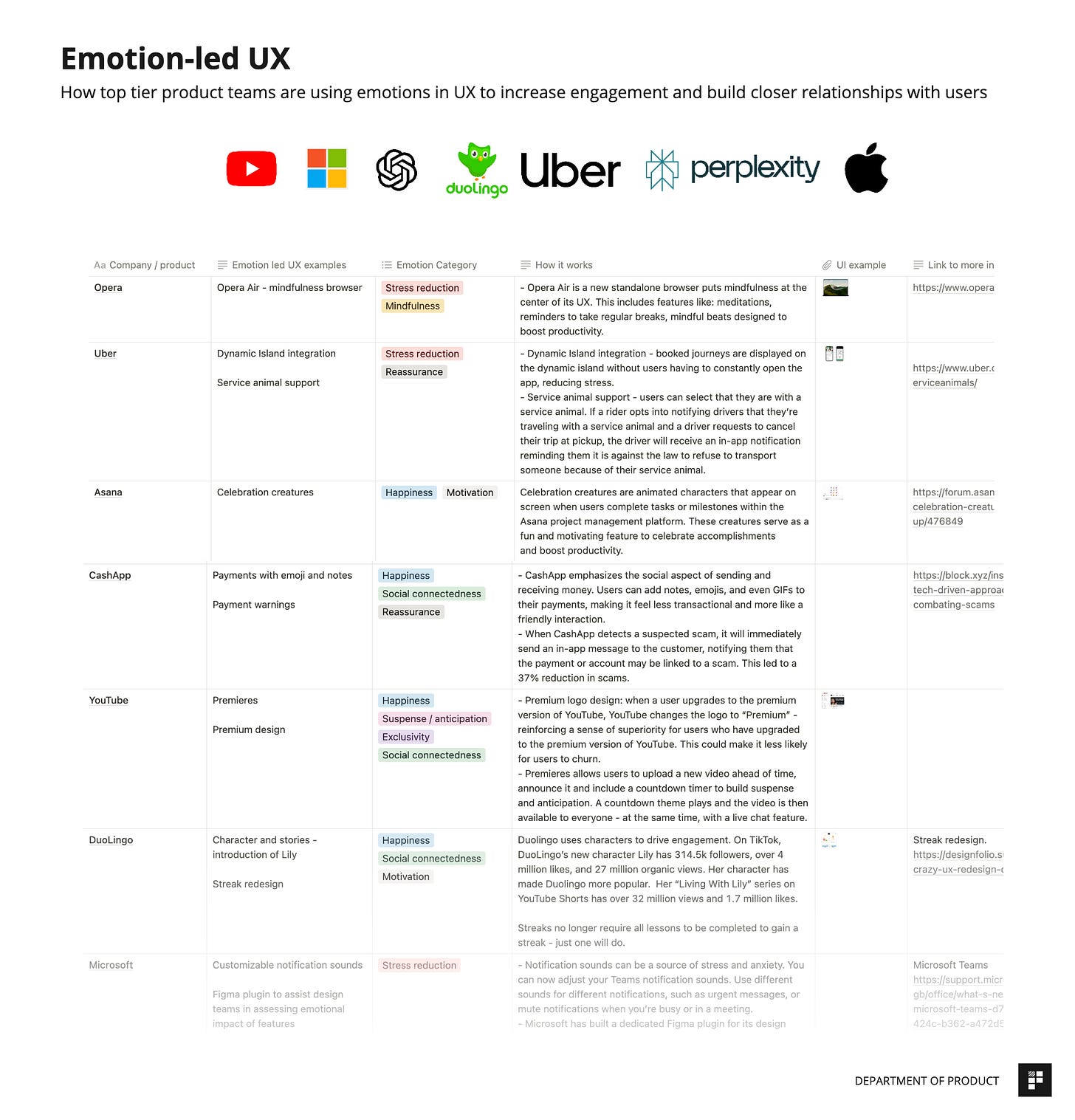Deep: Emotion-led UX Explored
Is emotion the next moat? Happiness, suspense, anticipation and more. How top products like ChatGPT, Pinterest, YouTube and others use UX to make you feel something.
🔒DoP Deep goes deeper into the concepts and ideas that are covered in the Weekly Briefing to help you learn lessons from the experiences of top tech companies. If you’d like to upgrade to receive these in-depth pieces of analysis you can upgrade below. New reports added every month.
Hi everyone 👋,
Is emotion the new competitive moat for software products?
This is the argument that was recently made by an exec at Figma who argued that “emotional resonance, not features, is the new competitive moat for software.” and that “the defining characteristic for an app won’t be its functionality; it will be how it makes users feel.”
Opera took this concept to a whole new level and built a new browser dedicated entirely to mindfulness and creating a feeling of calm. Spotify recently introduced more social features to help users feel more connected and companies like Microsoft have even developed an entire set of Figma plugins that its designers can use to sense check how a feature may emotionally impact a user. More on that later.
As AI makes it easier for users to build basic products from scratch in just a few hours, tech companies are increasingly scrambling for new ways to defend their moats - and the idea that emotional UX can work as a moat is certainly a thought provoking one. It takes time and careful consideration to craft something that elicits an emotional response and when it works well, it can transform the experience of using a product.
In this Deep dive, we’ll take a look at how some of the world’s leading companies are infusing emotion-driven UX into their products. Whether it’s feelings of exclusivity, excitement and anticipation or mindfulness and happiness, a product that’s capable of making you feel something is pretty powerful.
Coming up:
The full breakdown of 30+ emotion-led features and UX from leading companies including Apple, ChatGPT, Spotify, YouTube, DuoLingo, Uber and more - all categorized by emotional impact.
How haptic feedback can be used effectively in designing mobile devices - the surprising studies about how haptics can impact users emotions.
Why Microsoft built a Figma plugin that forces its designers to consider emotional impact, and how it's transforming their approach to product development.
A deeper look at how YouTube and Spotify craft powerful moments of anticipation and exclusivity to keep users coming back.
The list of all 30+ emotion UX / features in full.
How this analysis is structured
In this analysis, we take a deep look at how companies are integrating emotion into their UX. There are over 30 different examples of emotion-led UX and features in the report.
Here’s a snapshot of some of the examples covered:
Emotion UX categories explained
Emotion-led UX is a pretty difficult thing to categorize but I’ve done my best to group them into categories that make the most sense for each product.
The emotion UX categories include:
Stress reduction - Focuses on creating a sense of calm and reducing stress through features that promote mindfulness and well-being. Uber's integration with Dynamic Island helps reduce anxiety by displaying booked journeys without users needing to constantly open the app.
Suspense / anticipation - ChatGPT's haptic feedback on mobile devices builds anticipation as the AI begins its response. Other products craft UX which creates a feeling of suspense and anticipation in various ways. We’ll cover some of the most powerful examples.
Social connectedness - some features foster social engagement and a feeling of connectedness with other users. Spotify's "Blends" feature allows users to create shared playlists, fostering vulnerability through shared musical tastes. Research from Spotify suggests that users felt vulnerable but more connected after using the feature.
Mindfulness - Opera Air browser prioritizes mindfulness with features like meditations and break reminders. Other products are starting to introduce mindfulness into their design language.
Happiness - Asana's celebration creatures bring joy by appearing on screen when users complete tasks.
Reassurance - when users are completing tasks that are high security, high risk or require significant computations, UX can lend a hand in helping users feel more reassured. We’ll look at some recent examples of this from the likes of Perplexity, Notion and CashApp.
Exclusivity - for products with a premium tier or package, design teams can use this to their advantage to create a sense of exclusivity. YouTube does this to great effect with its Premium product. We’ll dig into the psychological principle that make it effective.
Motivation - motivating users to complete tasks can make it more likely that they’ll complete them. We’ll explore some examples together of how leading product teams subtly engage and motivate users to complete important goals.
Excitement - Airbnb's design teams ditched traditional filters on some of their listings and instead chose a very different way to filter listings to instill a sense of excitement and drive engagement.
A deeper look at the companies featured
Now let’s take a closer look at some of the companies featured in this deep dive along with some examples of emotion-led UX.


